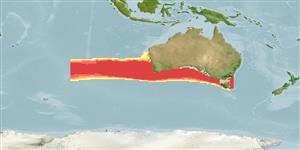Elasmobranquios (tiburones y rayas) (sharks and rays) >
Carcharhiniformes (Ground sharks) >
Pentanchidae (Deepwater catsharks)
Etymology: Asymbolus: Etymology not explained, possibly a-, Latin privative, i.e., without; sym-, from syn (Gr.), together or joined; bolus (L.), lump or morsel, proposed as a subgenus of Scyliorhinus (Scyliorhinidae) distinguished in part by labial fold of upper lip not hanging over lower-jaw symphysis of A. analis and A. vincenti. (See ETYFish); occiduus: Latin for western (of the setting sun), referring to its western distribution in Australian seas. (See ETYFish).
More on authors: Last, Gomon & Gledhill.
Environment: milieu / climate zone / depth range / distribution range
Ecología
marino; rango de profundidad 98 - 400 m (Ref. 36718). Temperate
Eastern Indian Ocean: Southwestern Australia.
Tamaño / Peso / Age
Maturity: Lm ? range ? - ? cm
Max length : 60.1 cm TL macho / no sexado; (Ref. 36712); 53.0 cm TL (female)
Short description
Morfología | Morfometría
Medium-sized body pale, yellowish green with 8 or 9 pale brownish saddles on the upper surface and sides; covered with sharply defined, brownish black spots; prominent dark spot usually beneath each eye and a single spot on dorsal midline between each saddle; trunk narrow; head relatively short. Caudal fin long, peduncle deep; dorsal and pelvic fins low; anal-fin base longer than pelvic-anal space. Teeth ridged, 5 main cusps. Monospondylous centra 37-41. Posterior margin of first dorsal fin 0.61-0.77 times its base (Ref. 36718).
Life cycle and mating behavior
Madurez | Reproducción | Puesta | Huevos | Fecundidad | Larva
Oviparous, paired eggs are laid. Embryos feed solely on yolk (Ref. 50449).
Last, P.R., M.F. Gomon and D.C. Gledhill, 1999. Australian spotted catsharks of the genus Asymbolus (Carcharhiniformes: Scyliorhinidae). Part 2: Descriptions of three new, dark-spotted species. p. 19-35. In P.R. Last (ed.). Australian catsharks of the genus Asymbolus (Carcharhiniformes: Scyliorhinidae). (Ref. 36718)
IUCN Red List Status (Ref. 130435)
Threat to humans
Harmless
Human uses
Más información
Age/SizeCrecimientoLength-weightLength-lengthLength-frequenciesMorfometríaMorfologíaLarvaDinámica larvariaReclutamientoAbundanciaBRUVS
ReferenciasAcuiculturaPerfil de acuiculturaRazasGenéticaElectrophoresesheritabilidadEnfermedadesProcesamientoNutrientsMass conversion
ColaboradoresImágenesStamps, Coins Misc.SonidosCiguateraVelocidadTipo de nataciónSuperficie branquialOtolitosCerebrosVisión
Herramientas
Special reports
Download XML
Fuentes de Internet
Estimates based on models
Preferred temperature (Ref.
123201): 13.1 - 16.4, mean 14.5 °C (based on 11 cells).
Phylogenetic diversity index (Ref.
82804): PD
50 = 0.5020 [Uniqueness, from 0.5 = low to 2.0 = high].
Bayesian length-weight: a=0.00355 (0.00176 - 0.00714), b=3.09 (2.91 - 3.27), in cm total length, based on LWR estimates for this (Sub)family-body shape (Ref.
93245).
Nivel trófico (Ref.
69278): 4.1 ±0.6 se; based on size and trophs of closest relatives
Resiliencia (Ref.
120179): Bajo, población duplicada en un tiempo mínimo de 4.5-14 años (Fec assumed to be <100).
Fishing Vulnerability (Ref.
59153): Moderate vulnerability (44 of 100).
